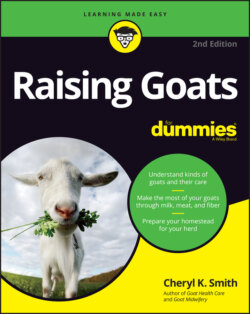Читать книгу Raising Goats For Dummies - Cheryl K. Smith - Страница 76
Myotonic goats
ОглавлениеMyotonic goats, also known as fainting or stiff-legged goats, are so named because of their tendency to go rigid and fall down when they’re startled. This is a genetic defect in a recessive gene that probably started in just one goat and then was continued through breeding. The repeated muscle tightening means that the goats have more muscle and are therefore good meat goats.
Fainting goats are often much smaller than Boers, weighing in at between 50 and 75 pounds and becoming no more than 25 inches tall. Those raised for meat, such as the Tennessee Meat Goat, can be much bigger — weighing up to 175 pounds or more.
They come in an array of colors and patterns and have long ears that stick out sideways. They often have long horns that curve backward. They can be shy animals (wouldn’t you be if you kept falling down at the most inopportune times?) but have sweet personalities.
These goats can be registered by either the Myotonic Goat Registry (MGR) or the International Fainting Goat Association (IFGA). These goats are currently listed as “recovering” on the Livestock Conservancy’s list of rare livestock breeds.
Myotonic goats, because of their diminutive size, may be a better choice for a meat goat breeder who has limited space to work with. The bucks can also be crossed with Boer does to grade up to higher meat production.
Some people buy fainting goats for the novelty of scaring them and watching them drop. The goats have allegedly served another purpose — protecting sheep when a predator comes around. The goat drops and the predator eats the goat instead of the sheep. That’s literally a sacrificial goat!
